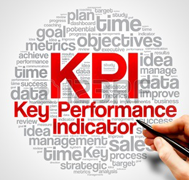Key Performance Indicators: Are You Focusing on the Right Ones?
 For any financial leader, key performance indicators (KPIs) are crucial for your business – you can’t live without them. They are used to measure success – what is working (successful) and what is not (unsuccessful). They can also help you identify areas for improvement – that, after all, is really the main goal of any KPI. But are you focusing on the right ones?
For any financial leader, key performance indicators (KPIs) are crucial for your business – you can’t live without them. They are used to measure success – what is working (successful) and what is not (unsuccessful). They can also help you identify areas for improvement – that, after all, is really the main goal of any KPI. But are you focusing on the right ones?
For some, the process of choosing the best key performance indicators can become overwhelming. After all, how do you judge what is important to measure and what isn’t? This means that some companies can become bogged down by KPIs.
The right key performance indicators depend on your industry and business model, and so we don’t believe there is a list of the ‘right’ ones. Instead, here are some best practices for choosing the right key performance indicators for your organization.
- Align your KPIs with your business goals. What are your organization’s goals? Have you identified any major areas for improvement or optimization? What are the biggest priorities? These questions will help you determine which KPIs are most important to measure.
- Consider both lagging and leading indicators. Lagging indicators, such as revenue, profit, and cost, are backward-focused and tell you about the outcome of past actions, allowing you to measure what worked in the past. Leading indicators help you understand and predict future results. Both are important, especially when it comes to forecasting.
- Make sure the KPIs you pick are attainable. While some KPIs may seem attractive, there is no point selecting a KPI if the data behind it can’t be obtained in a timely or cost-effective manner. When assessing value, always consider what it would take to get the information that would make the KPI count.
- On that note, don’t overdo it. KPI best practices typically suggest picking between 4 and 8 KPIs. Too few and you are likely missing key metrics. Too many and you’ll find yourself with a backlog of data.
Remember that KPIs are not static. While some are lasting, others will only be relevant within certain economic environments. Periodically review your processes for monitoring and acting on your KPIs and change those that are no longer relevant, replacing them with others that hold more value.
KPIs are a necessity as far as driving operational improvements, so choosing the ones that best suit your company is critical. We hope these best practices help.
It’s important to carefully choose the right key performance indicators for your dashboard so that key stakeholders have full visibility into the business at all times. Combined with the True Sky corporate performance management system, we can help you select the right KPIs and easily deliver this information to your people. Find out more by visiting www.truesky.com.



